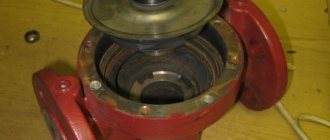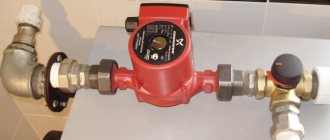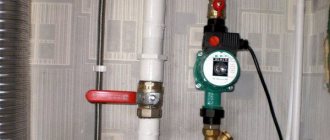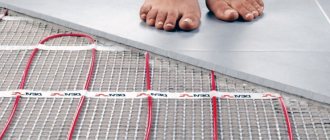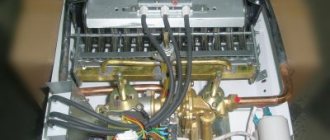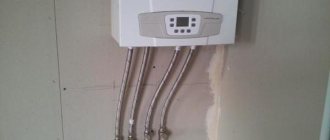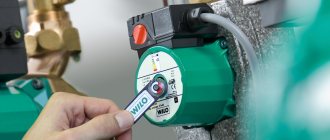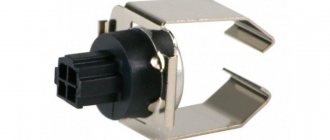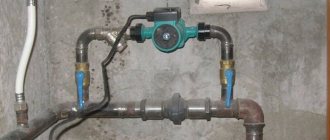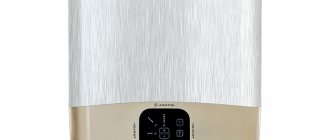Circulation pumps of various types are often used today in country houses and cottages, which makes the operation of autonomous heating systems more efficient and at the same time saves on energy resources. Meanwhile, if such a hydraulic machine fails, the entire heating system stops functioning, which forces its user to choose: use the services of qualified specialists or repair the heating circulation pump with his own hands.
Disassembling the circulation pump
The reasons for the breakdown of circulation pumps, the types of which differ from each other in certain design features, are associated both with non-compliance with the operating rules of such equipment, and with the quality of the coolant, fluctuations in the power supply network, as well as with a number of other factors. Before deciding to repair the circulation pump yourself, you should have a good understanding of the design and operating principle of such a device, which will allow you to determine the exact cause of its failure and eliminate it.
Common faults and solutions
The pump makes a loud noise when starting the pump, but the impeller does not spin. This usually happens if the engine shaft itself is oxidized or heavily rusted.
This happens due to the fact that the pump was installed at an angle from a horizontal reference, or due to the circulation pump being idle for a long time without use.
The process of restoring functionality is carried out as follows:
- The first step is to completely disconnect the device from the power supply.
- Drain the coolant from the pump and the adjacent piping circuit.
- Unscrew all pipeline connections (the so-called American ones), remove the motor along with the rotor.
- Take a strong plastic or wooden object, rest it on the pump body and force the impeller out of its dead position. After this, the pump should be reassembled in the reverse order; at first it will be a little noisy, but gradually it will get used to it and quiet down.
In rare cases, the pump begins to hum after a foreign object gets under the impeller. In such a situation, the pump is disassembled according to the instructions described above, the foreign body is removed, and then reassembled in the reverse order.
Only now you need to install a filter mesh before the coolant inlet so that a similar malfunction does not happen in the future.
The pump does not make any sounds and does not work
In this case, you should look for a fault in the power outlet or switch. An indicator screwdriver for determining the phase or a multimeter will help you with diagnostics. If everything is fine with the power in the outlet, then you should check the cable for a break.
If everything is fine here, then with a 90% probability the motor winding has been broken. Then the circulation pump needs to be replaced, since no one is restoring the winding.
We install the circulation pump ourselves and check it, or we call a specialist to your home for this work.
After a short period of operation, the pump turns off by itself.
This usually happens due to the fact that the water in the heating circuit is extremely highly mineralized, so lime deposits appear on the impeller during operation.
- Here the restoration work is not particularly complicated, you just need to disassemble the pump, dismantle it, and then disassemble it (just unscrew a few bolts around the perimeter of the device).
- Next, the impeller is cleaned; a brush and warm water with citric acid are ideal.
- After this, the working mechanism is washed under running water. At the end of the work, the circulation pump is assembled and subsequently installed.
When started, the pump spins and circulates coolant, but during operation it makes a loud noise.
This happens due to strong air in the heating system. To restore normal operation of the pump, you need to add water or antifreeze to the system, and then remove air from all pipes and radiators.
Boiler room maintenance cost
Technical (service) maintenance of the boiler room
| Name of works | Volume | Price |
| Service contract for floor-standing boiler (gas, diesel) up to 60 kW | with 1st scheduled departure | from 14 000 ₽ |
| Service contract for floor-standing boiler (gas, diesel) from 60 to 170 kW | with 1st scheduled departure | from 20 000 ₽ |
| Service contract for floor-standing boiler (gas, diesel) up to 60 kW | with 2 scheduled trips | from 22 000 ₽ |
| Service contract for floor-standing boiler (gas, diesel) from 60 to 170 kW | with 2 scheduled trips | from 30 000 ₽ |
| Service contract for wall-mounted gas boiler | with 1st scheduled departure | from 10 000 ₽ |
| Service contract for wall-mounted gas boiler | with 2 scheduled trips | from 15 000 ₽ |
| The exact cost is calculated after check-out | engineer |
Attention. This cost is a preliminary estimate; these prices should only be used as approximate prices. The exact cost of the work is calculated after an engineer visits the work site, its complexity, and quantity.
Boiler room repair, diagnostics and prevention
| Name of works | Volume | Price |
| On-site inspection and diagnostics (without repair) | up to 50 km from MKAD | from 3,500 ₽ |
| On-site inspection and diagnostics (without repair) | from 50 to 100 km from MKAD | from 5,500 ₽ |
| Cleaning the burner (atmospheric) | power up to 60 kW | from 2,000 ₽ |
| Cleaning the burner (supercharged) | power up to 60 kW | from 3,500 ₽ |
| Cleaning the burner (atmospheric) | power from 60 to 170 kW | from 8,500 ₽ |
| Cleaning the boiler combustion chamber | power up to 60 kW | from 4,000 ₽ |
| Cleaning the boiler combustion chamber | power from 60 to 170 kW | from 6,000 ₽ |
| Checking and pumping up pressure in the expansion tank | without dismantling work | from 2,500 ₽ |
| Checking and pumping up pressure on the expansion tank | with dismantling and installation | from 4 500 ₽ |
| Refilling the heating system with a pump | system volume up to 200 liters | from 3 000 ₽ |
| Replacement of heating element, pump, heat exchanger, with coolant drain | for a unit | from 3 000 ₽ |
| Conversion of a gas boiler to liquefied gas | for a unit | from 3 000 ₽ |
| Burner settings | gas / diesel | from 2 500 ₽ |
| The exact cost is calculated after check-out | engineer |
Attention. This cost is a preliminary estimate; these prices should only be used as approximate prices. The exact cost of the work is calculated after an engineer visits the work site, its complexity, and quantity.
The pump works but vibrates a lot
There are only 2 reasons for this:
- The rotor has somehow shifted from its normal axis of rotation;
- The working shaft bearing is worn out.
The problem is solved by replacing the bearing (if possible) or replacing the pump.
First of all
• It is better to buy circulation pumps from trusted manufacturers, this is both a guarantee of reliable operation of the device and guaranteed repair or replacement of the pump in case of failure
• Make sure that the liquid in the pipeline is not overheated and its temperature does not exceed the manufacturer’s permissible values.
• Monthly - During periods of inactivity, run the pump for at least 15 minutes. This will prevent clogging and oxidation of the pump shaft and help improve the efficiency of moving parts.
• Make sure electrical cables are properly protected from moisture.
• Make sure there are no leaks between the pump and the piping system.
• Make sure that the water pressure matches that specified in the technical data sheet
• The quality of the pumped water has a decisive influence on the longevity of the pump, so it is recommended to install a filter that catches any contaminants. Water quality is affected by many factors (including hardness, pH, impurities). Remember that the filter must be cleaned from time to time to remove contaminants deposited in it.
The pump creates a weak coolant circulation pressure
Main reasons:
- The pump impeller rotates in the opposite direction.
- The wiring in the electrical distribution box is incorrectly connected (with a 3-phase connection).
- Increased density of the coolant (this can happen due to the fact that dirty water was drawn into the system after repair work was carried out on the water supply main).
- The heating system filter element is clogged.
This problem is solved depending on the cause.
The cost of installing heating systems
Heating system installation
| Heating radiator installation | PC | from 2,000 ₽ |
| Installation of a floor-mounted convector | PC | from 4,500 ₽ |
| Installation of a heating radiator ( non-standard size, cast iron, design) | PC | from 4,500 ₽ |
| Installation of distribution heating cabinet | PC | 4 500 ₽ |
| A set of works for installing a heating system for a house up to 100 m² | from | 49 500 |
| A set of works for installing a heating system for a house up to 150 m² | from | 52 500 |
| A set of works for installing a heating system for a house up to 200 m² | from | 72 500 |
| A set of works for installing a heating system for a house up to 250 m² | from | 87 500 |
| Please call for exact cost | 84957446774 |
The cost of installing heating systems . The price was adjusted as of May 05, 2022 Attention. This cost is a preliminary estimate; these prices should only be used as approximate prices. The exact cost of the work is calculated after an engineer visits the work site, its complexity, and quantity.
Installation of an underfloor heating system (warm floor)
| Water heated floor | m² | from 500 ₽ |
| Distribution manifold cabinet for underfloor heating (external) | PC | 4 500 ₽ |
| Heated floor temperature control device | PC | from 2 000 ₽ |
| Heated floor temperature control groups (thermostatic valve, thermostat with clamp-on sensor, bypass valve, starter) | PC | 3 750 ₽ |
| Main pipes heating system and pipe insulation (cross-linked polyethylene, metal-plastic) up to 20 mm | m/linear | 100 ₽ |
| Main pipes heating system and insulation with pipe insulation (cross-linked polyethylene, metal-plastic) up to 32 mm | m/linear | 230 ₽ |
| The exact cost is calculated after check-out | engineer |
The cost of installing heating systems . The price was adjusted as of May 05, 2022 Attention. This cost is a preliminary estimate; these prices should only be used as approximate prices. The exact cost of the work is calculated after an engineer visits the work site, its complexity, and quantity.
Installation of heating systems for warehouses, hangars, workshops, car service centers
| Installation of a fan heater , with pipes, fastening to a concrete wall | PC | from 15 000 ₽ |
| Installation of automatic fan heater control | PC | from 4 500 ₽ |
| Pressure testing, commissioning, filling with coolant | m2 | from 100 ₽ |
| Register mounting, thread | PC | from 6 750 ₽ |
| Register installation, welding | PC | from 15 000 ₽ |
| The exact cost is calculated after check-out | _engineer_ |
The cost of installing heating systems . The price was adjusted as of May 05, 2022 Attention. This cost is a preliminary estimate; these prices should only be used as approximate prices. The exact cost of the work is calculated after an engineer visits the work site, its complexity, and quantity.
The pump gets very hot even when the boiler is cold
Excessive heating of the pump using cold coolant indicates that it is operating at increased load. Therefore, you should disassemble it yourself and check everything or send it to a diagnostic center, where this work will be performed by qualified craftsmen.
Unit features
The principle of operation of circulation pumping equipment is based on creating continuous circulation of liquid in the system without changing the pressure indicator
A circulation pump is a device that operates in a closed heating system and moves water in a pipeline. The unit maintains a certain temperature of the coolant in the system. The device does not replenish coolant losses and does not refill the system. The system is filled using a special pump or a certain pressure in the pipes.
The principle of operation of circulation pumping equipment is based on creating continuous circulation of liquid in the system without changing the pressure indicator. Since after installation the device operates constantly, the main requirements for such pumps are low noise level during operation, economical energy consumption, reliability, durability and ease of use.
Important: circulation pumps are compact devices that do not take up much space and do not create noise during operation. The scope of use of circulation units for heating systems is quite extensive.
They are installed:
The scope of use of circulation units for heating systems is quite extensive. They are installed:
- in traditional radiator systems;
- when installing a water heated floor;
- in geothermal systems;
- when organizing hot water supply for cottages and dachas.
Unlike forced circulation systems, this pumping equipment does not require pipes with an increased diameter. In addition, the device has the following advantages:
- speed of heating the room;
- the boiler can be installed in any suitable place;
- coolant losses and air pockets are minimized;
- The thermal relay ensures automatic control of temperature conditions;
- Electricity costs are reduced due to the use of automatic rotor speed control;
- Since liquid is constantly supplied to heating devices, their service life is extended.
How to disassemble a circulation pump
You need to understand that it is impossible to carry out high-quality repairs without disassembling the unit itself, so you need to learn how to disassemble it correctly.
First of all, the pump should be disconnected from the power supply.
- To disconnect the cable from the junction box, you need to remove the housing from the pump supply unit.
- After this, you need to close the ball valves at the edges of the pump, this is done so that the main part of the coolant remains in the system.
- Then all the bolts are unscrewed from the circulation pump housing, for this you use a socket wrench or hexagon
Note! You may encounter such a problem that the fasteners are thoroughly stuck. The popular WD-40 product will help you here; after half an hour you can try to unscrew the bolt again. This product is characterized by increased fluidity, so it is often used not only in everyday life, but also by plumbers and car mechanics.
Then carefully remove the cover of the unit, there you will see the pump motor itself, as well as the impeller, which distills the water in the system.
You need to remove the rotor; it is secured with several bolts in a circle. After this, you will have full access to all parts of the device, then it will be easier for you to diagnose and carry out repairs.
We are confident that you will be able to apply this material in practice and carry out competent repairs of the boiler circulation pump. Good luck to you!
Basic safety rules
Although the design of the circulation pump is quite simple, it will require certain qualifications to eliminate any breakdowns that occur. Therefore, it is easier to prevent a problem than to heroically eliminate it later. One sign that something is wrong with your equipment is if it becomes excessively hot during operation.
Compliance with the simplest operating rules will help prevent this:
- Under no circumstances should the wiring come into contact with moisture.
- Particular care should be taken to check the tightness of the connection between the pumping equipment and the pipeline. If there are leaks, the gaskets should be replaced.
- It is forbidden to turn on the device without first grounding it. The heating pump device includes special terminals.
- The internal pressure force should not exceed operating standards.
To figure out why the heating pump is not working, it is recommended to seek help from a professional technician. You can try to fix simple problems yourself.
